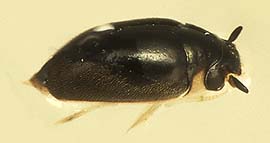
The whirligig beetles are water beetles, comprising the family Gyrinidae that usually swim on the surface of the water if undisturbed, though they swim underwater when threatened. They get their common name from their habit of swimming rapidly in circles when alarmed, and are also notable for their divided eyes which are believed to enable them to see both above and below water. The family includes some 700 extant species worldwide, in 15 genera, plus a few fossil species. Most species are very similar in general appearance, though they vary in size from perhaps 3 mm to 18 mm in length. They tend to be flattened and rounded in cross section, in plain view as seen from above, and in longitudinal section. In fact their shape is a good first approximation to an ellipsoid, with legs and other appendages fitting closely into a streamlined surface. Whirligig beetles belong to the beetle suborder Adephaga, which also includes ground beetles and diving beetles.

The Dytiscidae – based on the Greek dytikos (δυτικός), "able to dive" – are the predaceous diving beetles, a family of water beetles. They occur in virtually any freshwater habitat around the world, but a few species live among leaf litter. The adults of most are between 1 and 2.5 cm (0.4–1.0 in) long, though much variation is seen between species. The European Dytiscus latissimus and Brazilian Megadytes ducalis are the largest, reaching up to 4.5 cm (1.8 in) and 4.75 cm (1.9 in) respectively. In contrast, the smallest is likely the Australian Limbodessus atypicali of subterranean waters, which only is about 0.9 mm (0.035 in) long. Most are dark brown, blackish, or dark olive in color with golden highlights in some subfamilies. The larvae are commonly known as water tigers due to their voracious appetite. They have short, but sharp mandibles and immediately upon biting, they deliver digestive enzymes into prey to suck their liquefied remains. The family includes more than 4,000 described species in numerous genera.
Porrorhynchus is a genus of beetles in the family Gyrinidae, containing the following species:

Andogyrus is a subgenus of Macrogyrus, a genus of beetles in the family Gyrinidae. It was formerly considered a distinct genus, until a phylogenetic study in 2017 downgraded it in rank to a subgenus. It contains the following species:
Enhydrus is a genus of beetles in the family Gyrinidae, containing the following species:
Macrogyrus is a genus of beetles in the family Gyrinidae, containing the following species:

Spanglerogyrus albiventris is a species of beetle in the family Gyrinidae, the only species in the genus Spanglerogyrus. It is native to North America, and was described in 1979 from specimens found in southern Alabama. It is the only living member of the subfamily Spanglerogyrinae, the earliest diverging extant lineage of the gyrinids which also includes Angarogyrus from the Jurassic and Cretaceous of Asia.

Dineutus angustus is a species of whirligig beetles in the family Gyrinidae. It is found in North America.
Gyrinus maculiventris is a species of whirligig beetle in the family Gyrinidae. It is found in North America.

Dineutus hornii is a species of whirligig beetle in the family Gyrinidae. It is found in North America.

Dineutus carolinus is a species of whirligig beetle in the family Gyrinidae. It is found in the Caribbean Sea, Central America, and North America.

Dineutus ciliatus is a species of whirligig beetle in the family Gyrinidae. It is found in North America.

Dineutus assimilis is a species of whirligig beetle in the family Gyrinidae. It is found in North America.

Dineutus sublineatus is a species of whirligig beetle in the family Gyrinidae. It is found in Central America and the Southwestern United States.

Dineutus productus is a species of whirligig beetle in the family Gyrinidae. It is found in North America.

Dineutus emarginatus is a species of whirligig beetle in the family Gyrinidae. It is found in North America.

Dineutus nigrior is a species of whirligig beetle in the family Gyrinidae. It is found in North America.

Dineutus discolor, the large whirligig beetle, is a species of whirligig beetle in the family Gyrinidae. It is found in Central America and North America.
Chimerogyrus gigagalea is a fossil species of beetle in the family Gyrinidae, the only known species in the genus Chimerogyrus. It is known from a larval form found in Cenomanian aged Burmese amber of Myanmar. it was found to be a member of Gyrininae, sister to Dineutini + Orectochilini.
Porrorhynchus indicans, is a species of whirligig beetle found in Sri Lanka.















